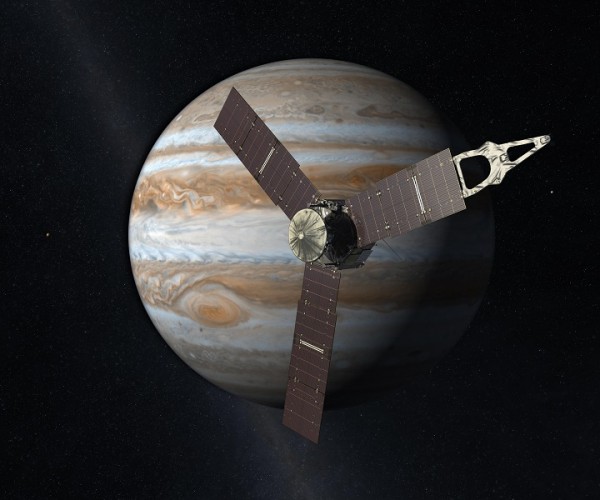By Ana Verayo, | February 08, 2016

Launching from Earth in 2011, the Juno spacecraft will arrive at Jupiter in 2016 to study the giant planet from an elliptical, polar orbit.
NASA's Juno spacecraft is now heading towards the biggest planet in the solar system, Jupiter, that have just completed executing the first of its two maneuvers from its new flight plan trajectory earlier this week. This brings the solar powered probe one step closer to its epic rendezvous with Jupiter within the next five months, according to NASA officials last week.
Like Us on Facebook
Juno was launched in August 2011 as it fired its thrusters around 1:38 P.M. EST on February 3, when it adjusted its speed to one foot for every second, burning 1.3 pounds of fuel for this first crucial maneuver, says NASA.
During the time of the maneuver, the probe was traveling at a distance of 51 million miles from the colossal gas planet, as Juno is now 425 million miles away from Earth. Its second maneuver is scheduled in May which is also part of the spacecraft's trajectory correction.
When the probe enters the Jovian system, Juno's mission involves orbiting Jupiter 33 times within a distance of 3,100 miles from the surface of Jupiter, which is located exactly among the planet's cloud cover, circling once every two weeks. These flybys will enable the probe to investigate the cloud cover and atmospheric conditions of the planet such as auroras, providing scientists with crucial data about the origins, structure and magnetosphere of Jupiter's surface and inner core.
Last January, Juno also broke a new distance record for a solar powered spacecraft that surpassed the European Space Agency's comet hunting Rosetta probe, upon reaching 493 million miles. When it arrives at Jupiter, Juno would also break another record, making it the eighth spacecraft to have travelled more than 500 million miles from our planet, and the first one to complete the 500 million mile mark using solar power instead of nuclear fuel.
As Juno approaches the system, the tiny craft is powered by its 30 feet long solar panel array that includes 18,000 solar cells. It will collect lesser energy now, about 1/25th of its energy as it did before, during its first part of its voyage. NASA scientists have utilized these massive solar arrays for efficient energy consumption that can convert light into energy, providing enough energy to keep the probe in full operations.
According to Juno principal investigator, Scott Bolton from the Southwest Research Institute in Texas, these maneuvers are very important in fine tuning Juno's orbit around the sun where it can also help achieve a perfect rendezvous with Jupiter scheduled on July 4 at 11:18 P.M. EDT.
-
Use of Coronavirus Pandemic Drones Raises Privacy Concerns: Drones Spread Fear, Local Officials Say

-
Coronavirus Hampers The Delivery Of Lockheed Martin F-35 Stealth Fighters For 2020

-
Instagram Speeds Up Plans to Add Account Memorialization Feature Due to COVID-19 Deaths

-
NASA: Perseverance Plans to Bring 'Mars Rock' to Earth in 2031

-
600 Dead And 3,000 In The Hospital as Iranians Believed Drinking High-Concentrations of Alcohol Can Cure The Coronavirus

-
600 Dead And 3,000 In The Hospital as Iranians Believed Drinking High-Concentrations of Alcohol Can Cure The Coronavirus

-
COVID-19: Doctors, Nurses Use Virtual Reality to Learn New Skills in Treating Coronavirus Patients







